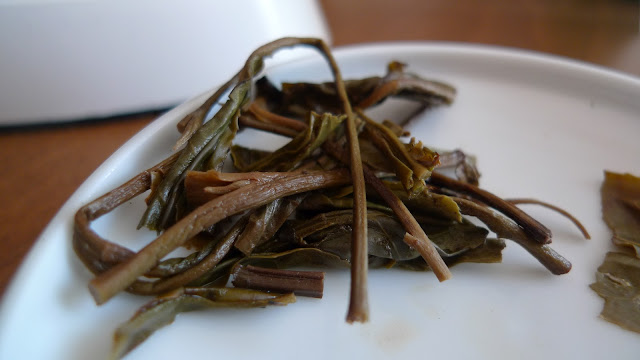This is another sample originally from Tea Urchin, yet sent to me by Hobbes. I am very grateful for a sample of this tea as it is one of the three samples which were sentenced to death for being red (sounds like Hobbes is an extremist right-wing dictator now; I do not believe it is the case though). I named a certain feature in tea "redness" too, independently on Half-Dipper. When reading posts by Hobbes, I thought it could be the same thing/taste - but up to now, I could not verify it. Therefore, this sample is an important piece to me as it shows how compatible is our terminology.
The photos show a slightly darker leaves (and twigs, there is a lot of them). Actually, I put recent samples of EoT side by side to this tea to compare the amount of redness. The leaves were very similarly colored, the difference was mostly in the tips/fur. Then I compared it to my "reddish tea benchmark" - 2011 Guan Zi Zai Youle - which was definitely redder (in the aroma too). Therefore, at this stage, I did not believe in the redness of the tea too much.
I do not smell anything peculiar in the aroma of the dry leaves. The wet leaves raise slight suspicion though - they start really well, being my beloved Yiwu dark fruit, but there is something I have not met in tea of this kind before and which smells a bit out of the place.
The liquor is a bit darker than one might expect, but nothing extra extraordinary in my opinion. And it starts rather yellow, but becomes orange gradually.
The liquor is thick and a very good mouthfeel starts quite early and is really nice - from the teas I have tried from Tea Urchin up to now (I'll publish the post about Xikong in few days, I consider it here too), this one is certainly the most intense in the way of mouthfeel.
However, certain redness is present :( Hobbes' inquisitorial eye must be really good and sensitive to see the redness in dry leaves - I did not perceive the leaves as abnormal, but the taste is what I understand to be a "too red puerh".
This being said, the overoxidation (probably) is not as intense to ruin the overally good feeling this tea gives to me. It is thick, sweet and with an above-average old-tree feeling.
It is not nearly as impotent as other "red" teas I have tried before either. It happily gave me 10 brews and would give a few more.
Furthermore, from the fourth brew on, I do not perceive the redness in taste - a not really outstanding, but pleasant flowery-fruity taste stays. The taste would not do that well on its own, but as it is nicely backed up by the thickness and sweetness, it feels good.
On the photo above, a randomly chosen sample of leaves has been taken out of the teapot.
Notice the brown band on the leaf here - a lot of leaves has similar bands/spots.
Overall, I did enjoy the session quite well. Although the redness is definitely a negative for me, it is not that bad and the very good mouthfeel made the session worthwhile. And, although it may not be the best benchmark, this tea, in my opinion, still strictly dominates all the Xizihaos I have written about, being cheaper on top. However, to balance this possibly overly positive paragraph, I have to say that this is a tea I enjoyed the least from the samples from Tea Urchin.
Further reading: Half Dipper
Further reading: Half Dipper






Žádné komentáře:
Okomentovat